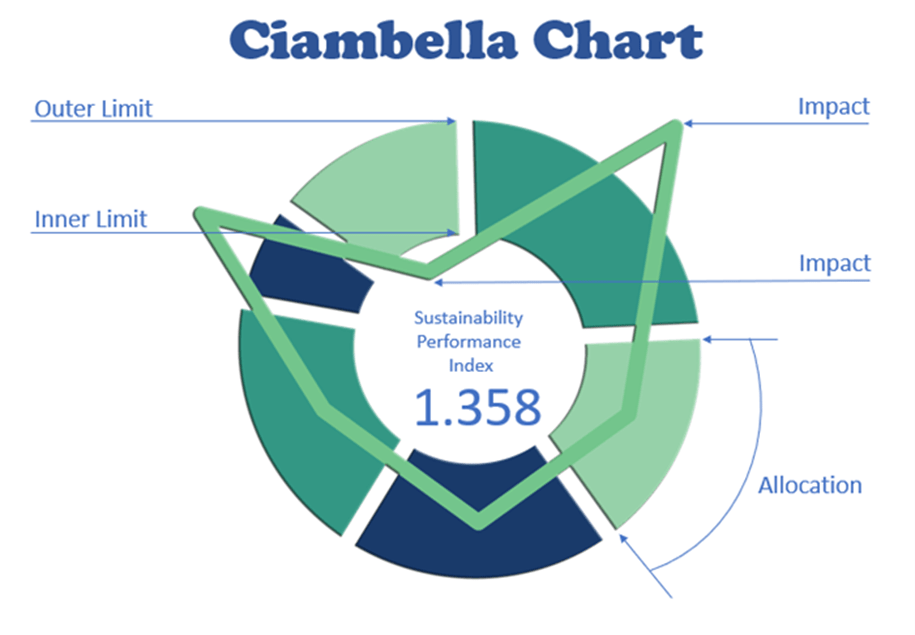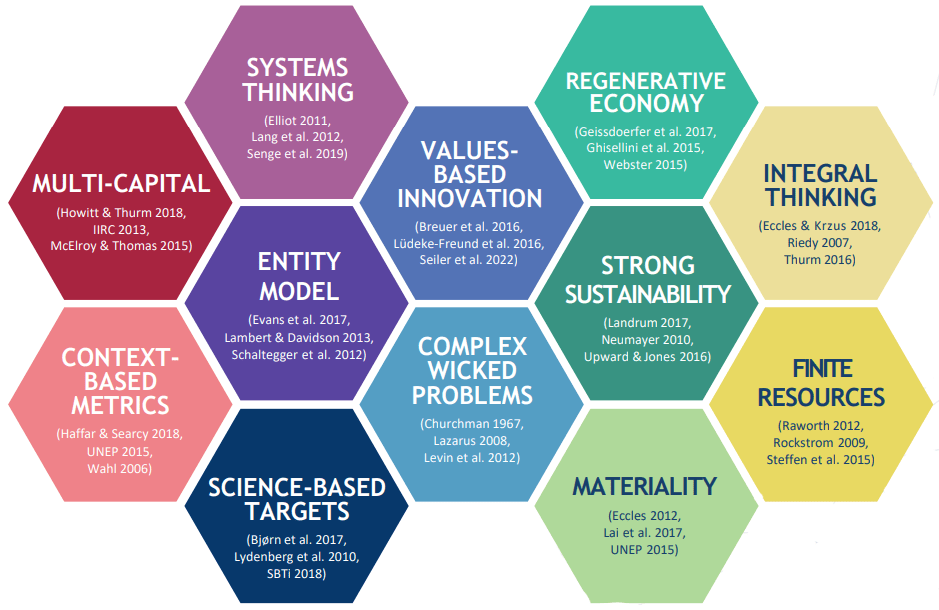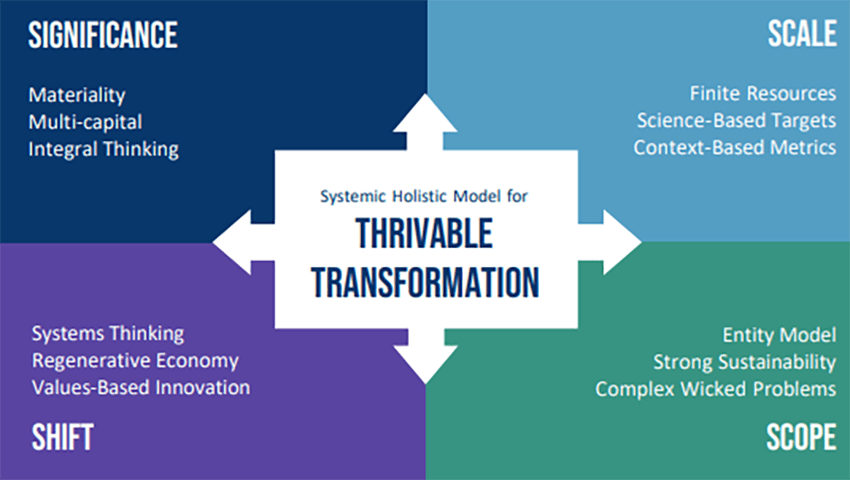Index:
- Introduction
- What is the THRIVE Framework?
- Global Relevance
- The 12 Foundational Focus Factors
- THRIVE Framework: Themes Today
- The Systemic Holistic Model
- Striving for Thrivability: Four Quadrants
- The Systemic Holistic Model: Moving Forward
- Achieving the United Nations Sustainability Development Goals (SDGs)
- THRIVE Framework and Clear Paths Forward
Introduction
The United Nations (UN) affiliated research group, THRIVE Project, is an international pioneer of global sustainability, setting the stage for widespread thrivability using a holistic model. THRIVE stands for The Holistic Regenerative Innovative Value Entity. The natural world is changing at an unprecedented rate in human history, with biodiversity loss, inequality and injustice, catastrophic fires, drought, floods, climate change, and accelerating viral epidemics. THRIVE is here to motivate and navigate individuals, groups, and companies away from an apocalyptic future and towards a Thrivable utopia.
What is the THRIVE framework?
The THRIVE Framework is a Holistic Regenerative Framework. It allows the contrasting approaches adopted by organisations concerned with sustainability to be infused into one clear template. Therefore, THRIVE’s Framework enables differing sustainability approaches to intersect and create a holistic, context-based, and systems-informed framework.
The purpose of the THRIVE Framework is to measure sustainability, assessing the performance of strategies and operations by integrating 12 Foundational Focus areas. In doing so, we can create a clear picture for future paths, with the intention of delivering on thrivability. The concept of Thrivability tackles environmental and social issues, looking beyond mere sustainability. THRIVE aims for a humanity that is able to survive and overcome the devastation inflicted upon the planet and, better yet, build the foundations for a world that thrives beyond this.
THRIVE recognises that the pursuit of human happiness can sometimes compete with environmental well-being. For that reason, THRIVE, in adherence to the 7 C’s, utilises our Ciambella chart to illustrate the concept of the ‘thrivable zone,’ and illuminate clear paths forward for the future.

Source: THRIVE Project

Source: THRIVE Project
Global Relevance
The world faces unprecedented threats, including climate change, deforestation, ocean depletion, and overuse of resources, along with many public health and social issues. Governments and organisations must, therefore, adopt strategies to combat these threats to ensure the continuation of human existence. In recent years, organisations and governing bodies have attempted to adopt innovative strategies to curtail these threats. These strategies include different approaches like Science-Based Targets, Values-Based Innovation, and Context-Based Metrics (Anderson et al., 2021), (Breuer et al., 2017), (McElroy, 2015).
Many of the impacts we see due to the current environmental crises are interconnected and overlap. Often, however, the strategies we adopt to combat these issues are too narrow-minded in their approach. As a result, proposed solutions fail, sometimes creating further loopholes in addressing the climate crisis. By utilising 12 Foundational Focus areas, THRIVE’s Framework makes it possible to solve this issue and holistically address the issues that we face globally. As such, integrating these 12 approaches gives a clear and complete cross-section of the required strategies going forward.
The 12 foundational focus factors
When the 12 Foundation Foundational Focus Factors work in tandem with one another, it becomes possible to ascertain clear insights into the most effective requirements for sustainability. This is why the THRIVE Framework is essential for delivering global thrivability. These 12 different approaches to sustainability comprise our Systemic Holistic Model, and are merged to create the THRIVE Framework.
- Materiality
- Context-Based Metrics
- Science-Based Targets
- Finite Resources
- Regenerative Economy
- Strong Sustainability
- Systems Thinking
- Integral Thinking
- Multi-Capital
- Values-Based Innovation
- Complex Wicked Problems
- Entity Model

Source: THRIVE Project
THRIVE Framework: Themes Today
International organisations promote important, recognised times and dates. ‘Earth Overshoot Day’, for example, explicitly records the world’s yearly allocated resources, as well as the date by which we surpass those yearly resources. Alarmingly, the data shows we have reached our yearly quota, and it is barely past the middle of the year (Earth Overshoot Day, 2023). Prior to the 1970s, there were plenty of resources for the entirety of each year.
Furthermore, various organisations promote another major cause for awareness: climate tipping points. These tipping points explain climate change as a result of abrupt or irreversible changes in degrees of temperature. Others are levels of arctic sheet melting and deforestation levels. These tipping points indicate our precarious position regarding the climate crisis (Carbon Brief, 2023). Such concerns also illustrate how many organisations have adopted the need to adapt and mitigate damage by utilising broad systemic approaches (NASA, 2023). This is where the THRIVE Framework fits in, as it demonstrates how vital the 12 Foundational Focus Factors are. Most importantly, it shows the necessity of how different factors must work coherently with each other in order to measure sustainability.
The systemic holistic model
Many organisations use aspects of our 12 Foundational Focus Factors in addressing sustainability challenges. When these factors are used in isolation, the results can fall short of a systemic, holistic overview of data. A holistic approach to sustainability enables expansive examination of data collated from a range of metrics and different models.
In order to thrive, humanity and the environment must co-exist beyond merely being sustainable. Different approaches measure sustainability throughout the world. These approaches assist in generating sustainable products, industries, and the responsible use of the Earth’s natural resources. With this in mind, an expansive approach integrates all perspectives. It is important to realise that acting in unison is necessary to measure sustainability and guide towards thrivability.

Source: THRIVE Project
Striving for Thrivability: The Four Quadrants
Significance within the Systemic Holistic Model
Significance considers why we need to address certain concerns and what the consequences are if we don’t. These impacts include droughts, floods, forest fires, and so on, affecting public health and political and economic stability. Sigificance similarly assesses the relevance and interdependencies of different types of resources. For example, financial capital, manufactured intellectual, human, social and relationship, and natural capital.
Significance includes the Foundational Focus Factor of Materiality, which relates to environmental, social, and governance issues that we may face, such as resource scarcity or unfair labour practices to attain resources (UNEP, 2015). Materiality means what is significant and relevant. However, it is important to note that what is material to one business might not be so to another.
A Multi-Capital approach, similar to Materiality, looks at the different environmental and social factors that exist in the world. These factors are relevant to the global economy and global ecosystem. Therefore, they are significant to the performance of any company and stakeholders. This approach opposes mono-capitalism, which is only concerned with economic value.
Integral Thinking is a theoretical approach that underpins how all actors should consider environmental and social factors associated with performance. It utilises global threshold templates like planetary boundaries and doughnut economics to guide Integral Thinking (Thurm, 2019). Integrated Reporting, which has existed recently (IFRS, 2023), attempts to adhere to Integral Thinking as a guiding principle but significantly detracts from the main purpose. The central premise of Integral Thinking is to create a more holistic and consistent approach and aims to measure beyond economic profits. As a result, integrating varied impact measurements on the environment and society creates a more holistic, well-rounded, and consistent picture of sustainability performance.
Scale within the Systemic Holistic Model
The Scale quadrant of the Systemic Holistic Model looks at the extent of various threats and how they must be managed. Accordingly, it considers the level of use regarding non-renewable resources and the implications of adverse climate issues on the world’s ecosystems, humanity, and economy. Scale promotes the need for understanding such issues in an organic way and not perceiving them in isolation.
It includes the Foundational Focus on Finite Resources, where we recognise that we do not have infinite resources at our disposal. Scale similarly relates to doughnut economics (Raworth, 2012) and Planetary Boundaries (Steffen, 2015). It also recognises that the natural world confines our economy and society. Our economy and society must exist within and co-exist within the parameters of the natural world.
Science-Based Targets considers the requirement of, and justification for, why a set target must be placed upon the basis of things such as climate threats. Also, it acknowledges the necessity of specific goals, measurable progress, and achieved targets. (National Science Review, 2021).
Context-Based Metrics overlaps with Science-Based Targets and ethics-based goals. These thereby prescribe organisation-specific allocations to maintaining environmental, social, and economic capital. These allocations must also meet the levels that benefit stakeholders (McElroy, 2015).
Scope within the Systemic Holistic Model
The Scope quadrant of the Systemic Holistic Model looks at the potential of Thrivability, through the recognition of the diverse range of context-based threats, which are often diverse and ever-changing. In sum, we need strong approaches and a holistic perspective.
Scope relates to the Foundational Focus Factor of Strong Sustainability. This seeks to maintain the integrity of all ecosystems with the capacity for complete natural regeneration, in which resource use does not exceed regeneration pace. It’s also where social and economic domains exist within the strong sustainability parameters (Pelenc et al., 2015).
The Entity Model Focus Factor looks at the conduct of businesses as they relate to stakeholders and environmental and social issues. This conduct also applies to the interaction with external groups of stakeholders (Fedeli et al., 2021) (Schaltegger et al., 2017). The scope of approaches must therefore look beyond the boundaries of a single entity toward a more global view, beyond a bottom-up approach to more of a top-down approach.
Complex Wicked Problems recognises the threats actors face in a complex array of systemic and existential threats. Above all, such threats require management, in which context is retained as part of a more global holistic approach. This is due to the interconnected nature and changeability of all things. For instance, the time constraint difficulties in solving issues, issues solved by those who cause them, a lack of central authority to address those problems, and the irrational disregard for the future (Levin et al., 2012).
Shift within the Systemic Holistic Model
The Shift quadrant highlights how all sustainability approaches must move toward Thrivability. This accordingly requires consistent values, different expertise from different disciplines, and a circular sustainability approach.
For that reason, shift considers the Focus Factor of Regenerative Economy. The Regenerative approach is a long-advocated model of sustainability and promotes the utility of systems as opposed to components (Webster, 2015). It also promotes the need for a sustainable circular economy to eradicate waste and promote reusability and recycling, whereas a linear economy exists upon the back of a surplus of resources.
Values-Based Innovation promotes the need for a values-based approach to sustainability. This enables productive innovation by integrating shared values on environmental, social, and other ethical concerns (Breuer et al., 2017).
Values-Based Innovation also promotes the need for Systems Thinking, which addresses the complexity of the crises faced and thus advocates for interdisciplinary and interconnected systems-based approaches. These systems-based approaches consider technologies, social practices, business models, regulations, and societal norms. Together, such integrated approaches facilitate the required change and transition to sustainability, which in turn allows the necessary shift to occur (Hunt et al., 2022).
The Systemic Holistic Model: moving forward
The Systemic Holistic Model is geared towards affecting positive change, including the focuses and approaches required for positive change. Using the 12 Foundational Focus Factors of the THRIVE Framework and recognising the Significance, Scale, Scope, and Shift required to address an issue allows this model to assess sustainability and enable Thrivability to unfold.
achieving the United Nations Sustainability Development Goals (SDGs)
The United Nation’s 17 Sustainable Development Goals (SDGs) are important goals to attain. These range from issues in education and human rights abuses to improving life on land and below water. They include renewable green technology, biodiversity protection and conservation of natural areas, and sustainable agriculture. Furthermore, the SDGs promote democracies, strong institutions, climate action, and equality between regions.
THRIVE Framework & The Clear Paths Forward
Political and social deliberations about climate change, social issues, or environmental issues can blur the understanding of strategies required to mitigate impacts. A band-aid response to one social issue pursued at a policy level often leads to a different approach to mitigating an environmental issue. Sometimes, these can be contradictory approaches. All the while, the Earth’s biosphere is continually affected. Political sparring and social debates, amongst convoluted perspectives, can stifle clarity, polarise viewpoints, and stagnate progress. Addressing issues in a holistic way, that is informed by science and realistically reflecting how issues in society exist, is essential. This is why both the THRIVE Framework and the Systemic Holistic Model are critical.
THRIVE Project invests interest in issues fundamental to the well-being of our society. It also ensures that every element of our global ecosystems is bettered in order to create a Thrivable planet. Safeguarding human well-being in all domains, as well as the well-being of nature and every living being, is paramount to THRIVE’s mission.
To learn more about how THRIVE Project is researching, educating and advocating for a future beyond sustainability, visit our website. You can follow our informative blog and podcast series, and learn about our regular live webinars featuring expert guests in the field. Sign up to our newsletter for regular updates.